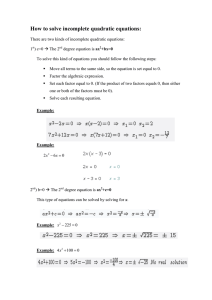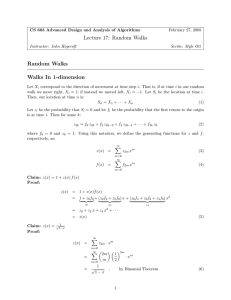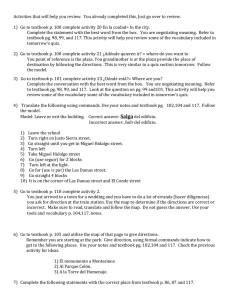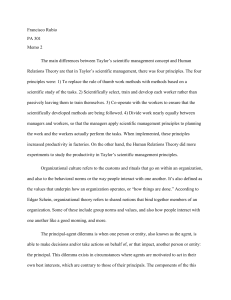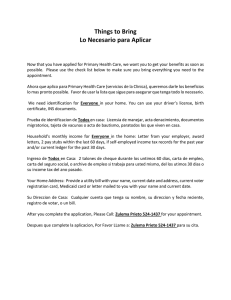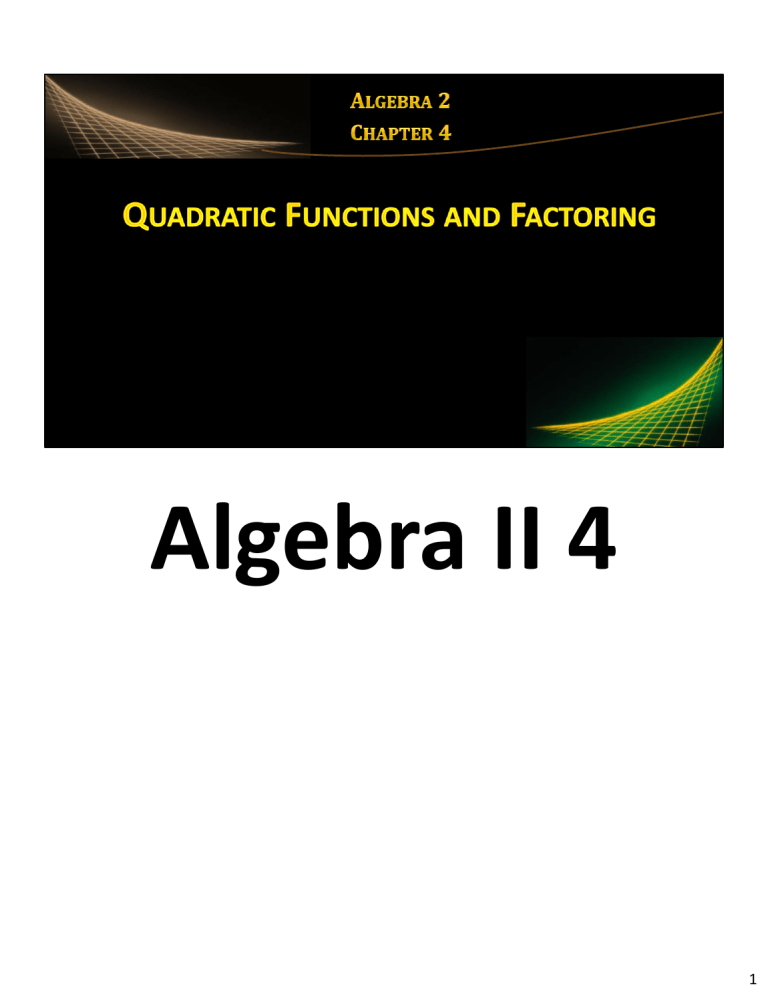
Algebra II 4 1 • This Slideshow was developed to accompany the textbook ▪ Larson Algebra 2 ▪ By Larson, R., Boswell, L., Kanold, T. D., & Stiff, L. ▪ 2011 Holt McDougal • Some examples and diagrams are taken from the textbook. Slides created by Richard Wright, Andrews Academy [email protected] 2 3 • This Slideshow was developed to accompany the textbook ▪ Larson Algebra 2 ▪ By Larson, R., Boswell, L., Kanold, T. D., & Stiff, L. ▪ 2011 Holt McDougal • Some examples and diagrams are taken from the textbook. Slides created by Richard Wright, Andrews Academy [email protected] 4 • Many physical events can be modeled with quadratic equations such as projectile motion. • The graph of a projectile versus time looks exactly like the path the projectile takes. 5 6 7 8 9 • Quadratic Function ▪ y = ax2 + bx + c • Shape is a “u” or parabola ▪ Opens up if a > 0; down if a < 0 ▪ If |a| > 1, then narrower than y = x2 ▪ If |a| < 1, then wider than y = x2 • Vertex → highest or lowest point ▪ x-coordinate is found by − 𝒃 𝟐𝒂 ▪ y-coordinate found by plugging − • Axis of symmetry → 𝑥 = − 𝑏 2𝑎 𝑏 2𝑎 into the equation 10 • How to Graph (Standard Form) ▪ Find and plot the vertex ▪ Make a table around the vertex ▪ Draw the curve through all 5 points 11 • Graph y = -x2 + 2x ▪ Find the vertex ▪ ➢ 𝑥=− ➢ 𝑥= 𝑏 2𝑎 2 − 2 −1 =1 Make a table of values with vertex in the middle x -2 -1 0 1 2 3 4 y -8 -3 0 1 0 -3 -8 12 • Graph y = 2x2 + 6x + 3 ▪ Find the vertex ▪ ➢ 𝑥=− ➢ 𝑥= 𝑏 2𝑎 6 − 2 2 =− 3 2 Make a table of values with vertex in the middle x -4 -3 -2 -3/2 -1 0 1 y 11 3 -1 -3/2 -1 3 11 Vertex at (-1.5, -1.5) → other points (-3, 3), (-2, -1), (-1, -1), (0, 3), (1, 11) 13 • Find the minimum value of y = 4x2 + 16x – 3 ▪ The minimum of a quadratic is at the vertex. 𝑏 2𝑎 16 − 2⋅4 ▪ 𝑥=− ▪ 𝑥= ▪ Find the y-value by plugging in the x. ▪ 𝑦 = 4 −2 2 + 16 −2 − 3 ▪ 𝑦 = −19 ▪ The minimum value is -19 ▪ 𝑥 = −2 Minimum occurs at vertex: x = -b/2a → x = -16/(2∙4) = -2 y = 4(-2)2 + 16(-2) – 3 = -19 The minimum value is -19 14 • • • • • • • • A video store sells about 150 DVDs a week for $20 each. The owner estimates that for each $1 decrease in price, about 25 more DVDs will be sold each week. How can the owner maximize weekly revenue? Revenue is how much money comes in. Revenue = Price × Number sold Price = $20 minus the $1 × number of decreases Number sold = 150 + 25 × number of decreases 𝑅 = 20 − 𝑥 150 + 25𝑥 𝑅 = 3000 + 500𝑥 − 150𝑥 − 25𝑥2 𝑅 = −25𝑥2 + 350𝑥 + 3000 • Maximum occurs at vertex • 𝑥 = − 2𝑎 • 𝑥 = −2 • • 𝑦 = −25 7 2 + 350(7) + 3000 = 4225 The owner should drop the price 7 times making the revenue $4225 𝑏 350 −25 =7 15 • 4.1 Homework Quiz 16 17 • This Slideshow was developed to accompany the textbook ▪ Larson Algebra 2 ▪ By Larson, R., Boswell, L., Kanold, T. D., & Stiff, L. ▪ 2011 Holt McDougal • Some examples and diagrams are taken from the textbook. Slides created by Richard Wright, Andrews Academy [email protected] 18 • Vertex Form ▪ y = a(x – h)2 + k ▪ (h, k) is vertex ▪ x = h is axis of symmetry • (h, k) is the vertex because, if h and k = 0, then y = ax2 ▪ The vertex of this is zero (from yesterday) ▪ We learned before that ➢ h is how far the graph moves right ➢ k is how far the graph moves up • Graph same way as before ▪ Find the vertex and make a table 19 • • • • • Graph 𝑦 = 2(𝑥 − 1)2 + 3 Compare to 𝑦 = 𝑎 𝑥 − ℎ 2 + 𝑘 𝑎 = 2, ℎ = 1 and 𝑘 = 3 Vertex is ℎ, 𝑘 = 1, 3 Make a table with x = 1 in the middle x -2 -1 0 1 2 3 4 y 21 11 5 3 5 11 21 20 • Intercept Form ▪ 𝑦 = 𝑎(𝑥 − 𝑝)(𝑥 − 𝑞) ▪ x-intercepts are p and q ▪ axis of symmetry is halfway between p and q • Graph the intercepts and find the axis of symmetry. ▪ Vertex → x-coordinate is axis of symmetry, plug in to equation to find y-coordinate 21 • • • • • Graph 𝑦 = (𝑥 − 3)(𝑥 + 1) Compare to 𝑦 = 𝑎 𝑥 − 𝑝 𝑥 − 𝑞 a = 1, p = 3, q = -1 x-int: 3 and -1 Vertex is half-way between ▪ 𝑥= 3+ −1 2 =1 • Make a table with x = 1 in center x -2 -1 0 1 2 3 4 y 5 0 -3 -4 -3 0 5 Vertex at (1, -4) → x-int at (3, 0) and (-1, 0) 22 • If an object is propelled straight upward from Earth at an initial velocity of 80 feet per second, its height after t seconds is given by ℎ(𝑡) = −16𝑡 𝑡 − 5 . ▪ How many seconds after it is propelled will the object hit the ground? ▪ This is in intercept form 𝑦 = −16 𝑡 − 0 𝑡 − 5 ▪ Thus it will be at zero height at the xintercepts which are at t = 0 or t = 5 seconds ▪ Choose the answer that makes sense: t=5s ▪ What is the object’s maximum height? ▪ Maximum height occurs at the vertex: ▪ x-intercepts are 0 and 5, so vertex is halfway between. ➢ 𝑡= 0+5 2 = 2.5 ▪ Plug this into the function to get h ▪ ℎ = −16 2.5 2.5 − 5 ▪ h = 100 feet This is in intercept form y = -16(t – 0)(t – 5) Thus it will be at zero height when either (t – 0) = 0 or (t – 5) = 0. t – 5 = 0 → t = 5 seconds Maximum height occurs at the vertex: intercepts are 0 and 5, so vertex is at t = 2.5 h(2.5) = -16(2.5)(2.5 – 5) = 100 feet 23 FOIL • To multiply 𝑥 + 2 𝑥 − 3 ▪ ▪ ▪ ▪ ▪ First → 𝑥 · 𝑥 = 𝑥 Outer → −3𝑥 Inner → 2𝑥 Last → 2 · −3 = −6 Add together → 𝑥 2 − 𝑥 − 6 2 • To multiply 𝑥 − 2 2 ▪ 𝑥−2 𝑥−2 ▪ FOIL ▪ 𝑥 2 − 4𝑥 + 4 24 • Write the quadratic function in standard form ▪ 𝑦 = − 𝑥−2 𝑥−7 • FOIL ▪ 𝑦 = − 𝑥 2 − 7𝑥 − 2𝑥 + 14 • Simplify ▪ 𝑦 = − 𝑥 2 − 9𝑥 + 14 ▪ 𝑦 = −𝑥 2 + 9𝑥 − 14 y = -(x – 2)(x – 7) → y = -(x2 – 7x – 2x + 14) → y = -(x2 – 9x + 14) → y = -x2 + 9x – 14 25 • Write the quadratic function in standard form ▪ 𝑓 𝑥 =− 𝑥+2 2+4 • 𝑥+2 2 = 𝑥+2 𝑥+2 ▪ 𝑓 𝑥 =− 𝑥+2 𝑥+2 +4 • FOIL ▪ 𝑓 𝑥 = − 𝑥 2 + 2𝑥 + 2𝑥 + 4 + 4 • Simplify ▪ 𝑓 𝑥 = − 𝑥 2 + 4𝑥 + 4 + 4 • Distribute ▪ 𝑓 𝑥 = −𝑥 2 − 4𝑥 − 4 + 4 ▪ 𝑓 𝑥 = −𝑥 2 − 4𝑥 f(x) = -(x + 2)2 + 4 → f(x) = -(x + 2)(x + 2) + 4 → f(x) = -(x2 + 2x + 2x + 4) + 4 → f(x) = -(x2 + 4x + 4) + 4 → f(x) = -x2 – 4x – 4 + 4 → f(x) = -x2 – 4x 26 • 4.2 Homework Quiz 27 28 • This Slideshow was developed to accompany the textbook ▪ Larson Algebra 2 ▪ By Larson, R., Boswell, L., Kanold, T. D., & Stiff, L. ▪ 2011 Holt McDougal • Some examples and diagrams are taken from the textbook. Slides created by Richard Wright, Andrews Academy [email protected] 29 • Factoring is the opposite of FOILing • Factoring undoes multiplication • (x + 2)(x + 5) = x2 + 7x + 10 ▪ x + 2 called binomial ▪ x2 + 7x + 10 called trinomial 30 • Factoring trinomial ▪ ax2 + bx + c 1. Write two sets of parentheses ( )( ) 2. Guess and Check 3. The Firsts multiply to make ax2 4. The Lasts multiply to make c 5. Check to make sure the Outers + Inners make bx 31 • Factor the expression ▪ x2 – 3x – 18 ▪ ( x − 9 )( x + 2) ➢ Test outers + inners: 2x + -9x = -7x ➢ Not -3x so doesn’t work ▪ (x − 6 )( x + 3) ➢ Test outers + inners: 3x + -6x = -3x ➢ This is -3x, so it works ▪ n2 – 3n + 9 ▪ ( n − 3 )( n − 3) ➢ Test outers + inners: -3n + -3n = -6n ➢ Not -3n so doesn’t work ▪ (n − 9 )( n − 1) ➢ Test outers + inners: -1n + -9n = -10n ➢ Not -3n, so doesn’t work ▪ We have no more factors of 9, so this is not factorable (x – 6)(x + 3) Cannot be factored 32 • Factor the expression ▪ r2 + 2r – 63 ▪ (r − 9 )( r + 7 ) ➢Test outers + inners: 7r + -9r = -2r ➢Not 2r so doesn’t work ▪ (r + 9 )(r − 7 ) ➢Test outers + inners: -7r + 9r = 2r ➢This is 2r, so it works (r + 9)(r – 7) 33 • Special patterns ▪ Difference of Squares ➢ a2 – b2 = (a – b)(a + b) ▪ Perfect Squares ➢ a2 ± 2ab + b2 = (a ± b)2 • Factor ▪ x2 – 9 ▪ Difference of squares ➢ x2 − 3 2 ▪ (x − 3)(x + 3) Difference of Squares: x2 – 9 = (x – 3)(x + 3) 34 • Special patterns ▪ Difference of Squares ➢ a2 – b2 = (a – b)(a + b) ▪ Perfect Squares ➢ a2 ± 2ab + b2 = (a ± b)2 • Factor ▪ w2 – 18w + 81 ▪ Perfect Square ➢ w2 − 2×9×w + 92 ▪ (w − 9)2 Perfect Squares: w2 – 18w + 81 = (w – 9)2 35 • Solving quadratic equations by factoring ▪ The solutions to quadratic equation are called zeros • Zero Product Property ▪ Zero times anything = 0 ▪ If ab = 0, then a = 0, b = 0, or both. ▪ Thus we can factor a quadratic equation (remember factoring gives you at least two pieces multiplied together) and set each factor equal to zero to solve. 36 • Solve ▪ 𝑥 2 − 𝑥 − 42 = 0 ▪ 𝑥−7 𝑥+6 =0 = bx: ▪ Check 𝑥 − 7outers = 0 + inners 𝑥+ 6=0 6x + -7x = -x ✔ ▪ 𝑥=7 𝑥 = −6 ▪ Solutions are x = -6, 7 ▪ 𝑥 2 − 8𝑥 + 16 = 0 ▪ 𝑥−4 𝑥−4 =0 bx:= 0 ▪ Check 𝑥 − 4outers = 0 + inners 𝑥 −= 4 -4x + -4x = -8x ✔ ▪ 𝑥=4 𝑥=4 ▪ Solutions are x = 4 x2 – 8x + 16 = 0 → (x – 4)(x – 4) = 0 → x–4=0→x=4 Solutions are x = 4 37 • Finding Zeros ▪ Zeros are the values of x when y = 0 ➢ Also called x-intercepts or roots ▪ When you find zeros make 𝑦 = 0 and solve • Find the zeros of 𝑦 = 𝑥 2 − 7𝑥 − 30 by rewriting the function in intercept form. ▪ ▪ ▪ ▪ ▪ 𝑦 = 𝑥 2 − 7𝑥 − 30 𝑦 = 𝑥 − 10 𝑥 + 3 𝑥 − 10 = 0 𝑥+3 = 0 𝑥 = 10 𝑥 = −3 Zeros are -3, 10 38 • 4.3 Homework Quiz 39 40 • This Slideshow was developed to accompany the textbook ▪ Larson Algebra 2 ▪ By Larson, R., Boswell, L., Kanold, T. D., & Stiff, L. ▪ 2011 Holt McDougal • Some examples and diagrams are taken from the textbook. Slides created by Richard Wright, Andrews Academy [email protected] 41 • Very similar to yesterday’s lesson • Two differences ▪ Factor monomial first ▪ Make a work just like c 42 • Monomial First ▪ Factor out any common terms first, then factor what’s left • • • • 14𝑥 2 + 2𝑥 − 12 2 7𝑥 2 + 𝑥 − 6 2( 7x − 6 )( x +1) Check outers + inners: • 3𝑥 2 − 18𝑥 • 3𝑥 𝑥 − 6 • There are no more x’s with exponents and we factored the monomial, so we are done factoring. ▪ 7x + -6x = x ✔ →2(7x2 + x – 6) → 2(7x – 6)(x + 1) → 3x(x – 6) 43 • Factor ▪ ▪ ▪ ▪ 12𝑥 2 + 3𝑥 + 3 3 4𝑥 2 + 𝑥 + 1 3 4𝑥 + 1 𝑥 + 1 Check outers + inners: ▪ ▪ ▪ ▪ 2𝑥 2 − 32 2 𝑥 2 − 16 Difference of squares 2 𝑥−4 𝑥+4 ➢ 4𝑥 + 1𝑥 = 5𝑥 Nope ▪ 3 2𝑥 + 1 2𝑥 + 1 ➢ Check 2x + 2x = 4x Nope ▪ No other options, so just ▪ 3 4𝑥 2 + 𝑥 + 1 3(4x2 + x + 1) 2(x2 – 16) → 2(x – 4)(x + 4) 44 • Solve ▪ ▪ ▪ ▪ 9𝑡 2 − 12𝑡 + 4 = 0 Monomial first: there is none 3𝑡 − 2 3𝑡 − 2 = 0 Check outers + inners: Each = −12𝑡 0 ✔ − 6𝑡 factor + −6𝑡 = ➢ 3𝑡 − 2 = 0 ➢ 3𝑡 = 2 ➢𝑡 = 2 3 ▪ 3𝑥 − 6 = 𝑥 2 − 10 ▪ Put in standard form (subtract 3x and add 6) ➢ 0 = 𝑥 2 − 3𝑥 − 4 ▪ Factor ➢0 = 𝑥 − 4 𝑥 + 1 Check outers + inners: ▪ Each factor = 0 1𝑥 + −4𝑥 = −3𝑥 ✔ ➢𝑥 − 4 = 0 𝑥+1=0 ➢𝑥 = 4 𝑥 = −1 ANS: (3t – 2)2 = 0 → 3t – 2 = 0 → 3t = 2 → t = 2/3 ANS: Put in standard form x2 – 3x – 4 = 0 (x – 4)(x + 1) = 0 x–4=0→x=4 x + 1 = 0 → x = -1 45 • You are designing a garden. You want the garden to be made up of a rectangular flower bed surrounded by a border of uniform width to be covered with decorative stones. You have decided that the flower bed will be 22 feet by 15 feet, and your budget will allow for enough stone to cover 120 square feet. What should be the width of the border? 22 x x 15 46 • • • • • • • • • Outer rectangle area – inner rectangle area = 120 2𝑥 + 22 2𝑥 + 15 − 22 15 = 120 4𝑥 2 + 30𝑥 + 44𝑥 + 330 − 330 = 120 4𝑥 2 + 74𝑥 = 120 4𝑥 2 + 74𝑥 − 120 = 0 Factor monomial: ▪ 2 2𝑥 2 + 37𝑥 − 60 = 0 Factor trinomial: ▪ 2 2𝑥 − 3 𝑥 + 20 = 0 Each factor = 0 ▪ 2𝑥 − 3 = 0 𝑥 + 20 = 0 ▪ 2𝑥 = 3 𝑥 = −20 3 2 ▪ 𝑥= Can’t use negative numbers Border is 3/2 feet or 1.5 feet or 18 inches 22 x x 15 47 • 4.4 Homework Quiz 48 49 • This Slideshow was developed to accompany the textbook ▪ Larson Algebra 2 ▪ By Larson, R., Boswell, L., Kanold, T. D., & Stiff, L. ▪ 2011 Holt McDougal • Some examples and diagrams are taken from the textbook. Slides created by Richard Wright, Andrews Academy [email protected] 50 • Find ▪ 36 ➢6 ▪ 9 ➢3 ▪ 4 ➢2 • What do you notice? ▪ 6 = 3 × 2 and 36 = 9 × 4 √36 = √9√4 51 • Square Root Definition ▪ If a2 = b, then a is the square root of b ▪ A positive number has 2 square roots shown by 𝑏 and − 𝑏 radical sign radicand 36 ▪ Expression with radical sign is called a radical expression • Simplifying ▪ All perfect squares taken out ▪ No radicals in denominator The term radical comes from Latin “radix” which means “root”. Other terms with same root: “Radish”, “eradicate” (pull out be roots) 52 • Properties of square roots • Product Property ▪ 𝑎𝑏 = 𝑎 𝑏 • Quotient Property ▪ 𝑎 𝑏 = 𝑎 𝑏 • Simplify ▪ 500 ➢ 100 5 ➢ 10 5 ▪ 3 12 6 ➢ 3 72 ➢ 3 36 2 ➢3 6 2 ➢ 18 2 53 • Simplify ▪ 25 3 • Multiply top and bottom by conjugate 2 − 3 to 5 ➢ remove the radical from 3 Multiply top and bottom the denominator. 5 3 by 3 to remove the ➢ 3 3 radical from the 5 3 denominator. ➢ 5 2+ 3 ▪ ▪ 5 2− 3 2+ 3 2− 3 10−5 3 4−3 ▪ 10 − 5 3 3 54 • Solving Quadratic Equations by finding square roots ▪ ▪ When? Only 1 term with x and it is squared Isolate the square and then take the • Solve ▪ ▪ 3 − 5𝑥 2 = −9 −5𝑥 2 = −12 ▪ 𝑥2 = 12 5 ▪ 𝑥=± ▪ 𝑥=± 12 5 12 5 2 3 5 ± 5 5 ▪ 𝑥= ▪ 𝑥=± 2 15 Solve for the x2. Rationalize the denominator by multiplying top and bottom by 5. 5 ANS: -5x2 = -12 → x2 = 12/5 → x = (12/5) → x = 12/5 → x=23 5 / 5 5 → x = 215 / 5 ANS: (x – 2)2 = 7 → x – 2 = 7 → x = 2 7 55 • Solve ▪ 3 𝑥 − 2 2 = 21 ▪ 𝑥−2 2 =7 Solve for the squared portion. ▪ 𝑥−2=± 7 Take ± square root. ▪ 𝑥 =2± 7 56 • 4.5 Homework Quiz 57 58 • This Slideshow was developed to accompany the textbook ▪ Larson Algebra 2 ▪ By Larson, R., Boswell, L., Kanold, T. D., & Stiff, L. ▪ 2011 Holt McDougal • Some examples and diagrams are taken from the textbook. Slides created by Richard Wright, Andrews Academy [email protected] 59 • When we were young we learned to count. • Then as we got older we learned to operate with combining those counting numbers. • Next we learned about negative numbers and fractions. With this came more rules for the operations. • Finally we are going to learn about complex numbers and the rules for dealing with them. 60 • Imaginary Number (imaginary unit) • Simplify ▪ ▪ i ▪ i = −1 ▪ i2 = -1 −9 ➢ 9 −1 ➢ 3𝑖 ▪ −12 ➢ 4 3 −1 ➢ 2 3𝑖 →3i → i43 → 2i3 61 i • Complex Number ▪ Includes real numbers and imaginary numbers • Imaginary numbers are any number with i ▪ • 𝑎 + 𝑏𝑖 where a and b are real Real Plotting ▪ Complex plane → x-axis is the real axis; y-axis is the imaginary axis • Plot ▪ −4 − 𝑖 ▪ 5 ▪ 1 + 3i 62 • Adding and Subtracting Complex Numbers ▪ Add the same way you add 𝑥 + 4 + 2𝑥 − 3 = 3𝑥 + 1 ▪ Combine like terms • Simplify ▪ −1 + 2𝑖 + 3 + 3𝑖 ▪ −1 + 3 + 2𝑖 + 3𝑖 ▪ 2 + 5𝑖 63 • Simplify ▪ 2 − 3𝑖 − 3 − 7𝑖 ▪ 2 − 3 + −3𝑖 − −7𝑖 ▪ −1 + 4𝑖 ▪ 2𝑖 − 3 + 𝑖 + 2 − 3𝑖 ▪ −3 + 2 + 2𝑖 − 𝑖 + −3𝑖 ▪ −1 − 2𝑖 64 • Multiplying complex numbers ▪ FOIL ▪ Remember 𝑖 2 = −1 • Multiply ▪ ▪ ▪ ▪ −𝑖 3 + 𝑖 −3𝑖 − 𝑖 2 −3𝑖 − −1 1 − 3𝑖 65 • Multiply ▪ ▪ ▪ ▪ ▪ 2 + 3𝑖 −6 − 2𝑖 −12 − 4𝑖 − 18𝑖 − 6𝑖 2 −12 − 22𝑖 − 6 −1 −12 − 22𝑖 + 6 −6 − 22𝑖 ▪ ▪ ▪ ▪ ▪ 1 + 2𝑖 1 − 2𝑖 1 − 2𝑖 + 2𝑖 − 4𝑖 2 1 − 4 −1 1+4 5 -3i – i2 = 1 – 3i -12 – 4i – 18i – 6i2 = -6 – 22i 1 – 2i + 2i – 4i2 = 5 66 ▪ Notice on the last example that the answer was just real • Complex conjugate → same numbers just opposite sign on the imaginary part ▪ When you multiply complex conjugates, the product is real • Dividing Complex Numbers ▪ To divide, multiply the numerator and denominator by the complex conjugate of the denominator ▪ No imaginary numbers are allowed in the denominator when simplified 67 • Divide • • • 2−7𝑖 1+𝑖 2−7𝑖 1−𝑖 1+𝑖 1−𝑖 2−2𝑖−7𝑖+7𝑖 2 1−𝑖+𝑖−𝑖 2 Multiply the top and bottom by the conjugate of the denominator. • 2−9𝑖+7 −1 1− −1 • −5−9𝑖 2 5 9 − − 𝑖 2 2 • 68 • Absolute Value • Find 2 − 4𝑖 ▪ Distance a number is from the origin ▪ 22 + −4 ▪ 𝑎 + 𝑏𝑖 = 𝑎2 + 𝑏2 ▪ 4 + 16 ▪ 20 ▪ 4 5 ➢ This is the distance formula (or Pythagorean Theorem) 2 ▪ 2 5 69 • Mandelbrot Set ▪ Fractal picture created using complex numbers • In the following pictures ▪ the black is part of the Mandelbrot Set ▪ The color is based on the number of iterations before 𝑧 > 5 We’ll find out about z later 70 71 • Solve the quadratic equation ▪ 𝑥 2 − 8 = −36 ▪ 𝑥 2 = −28 ▪ 𝑥 = ± −28 ▪ 𝑥 = ± 4 7 −1 ▪ 𝑥 = ±2 7𝑖 72 • 4.6 Homework Quiz 73 74 • This Slideshow was developed to accompany the textbook ▪ Larson Algebra 2 ▪ By Larson, R., Boswell, L., Kanold, T. D., & Stiff, L. ▪ 2011 Holt McDougal • Some examples and diagrams are taken from the textbook. Slides created by Richard Wright, Andrews Academy [email protected] 75 • • • • • • The Perfect Square 𝑥+3 2 𝑥+3 𝑥+3 𝑥 2 + 3𝑥 + 3𝑥 + 32 𝑥 2 + 2 3𝑥 + 32 𝑥 2 + 6𝑥 + 9 • 𝑥 + 𝑘 2 = 𝑥 2 + 2𝑘𝑥 + 𝑘 2 • Compare to 𝑎𝑥 2 + 𝑏𝑥 + 𝑐 • If you know the middle coefficient (b), then c is ▪ 𝑐= 𝑏 2 2 =(x + 3)(x + 3) = x2 + 2(3x) + 32 = x2 + 6x + 9 76 • What should c be to make a perfect square ▪ 𝑥 2 + 8𝑥 + 𝑐 ▪ 𝑐= ▪ 𝑐= 𝑏 2 2 8 2 2 42 ▪ 𝑐= ▪ 𝑐 = 16 you have to add (8/2)2 = 42 = 16 to get a perfect square or (x + 4)2 77 • • • • • • Rewrite the quadratic so x terms on one side and constant on other. If the leading coefficient is not 1, divide everything by it. Complete the square: add 𝑏 2 2 both sides. Rewrite the left hand side as a square (factor) Square root both sides Solve to x2 + 6x = 16 It already is x2 + 6x + x2 6 2 2 = 16 + 6 2 2 32 + 6x + = 16 + 9 (x + 3)2 = 25 x+3=5 x = -3 5 x = 2, -8 78 • Solve 2𝑥 2 − 11𝑥 + 12 = 0 ▪ 2𝑥 2 − 11𝑥 = −12 ▪ 𝑥2 − 11 𝑥 2 ▪ 𝑥2 − 11 𝑥+ 2 11 2 ▪ 𝑥− ▪ 𝑥− ▪ 𝑥− 4 11 2 4 11 2 4 Get constant on 11 5 ▪ 𝑥 − 4 = ±4 other side. Divide to get a = 1. 11 5 ▪ 𝑥= = −6 − 11 2 4 = −6 + 96 121 16 = − 16 + 25 = 16 = −6 + − 121 16 11 2 4 Solve for x. ± 4 4 11±5 2 ▪ 𝑥= 𝑏 Add 2 to both 4 3 ▪ 𝑥 = 4, 2 sides. Write left as square and simplify right. 79 The area of the rectangle is 56. Find the value of x. ▪ • • • ▪ 𝑥+ =± • • • 𝐴 = 𝑙𝑤 4𝑥 2𝑥 + 3 = 56 8𝑥 2 + 12𝑥 = 56 4𝑥 3 2 3 2 3 2 4 𝑥+ 3 = 7+ =7+ = ▪ 𝑥+4=± 𝑥2 + 𝑥 = 7 𝑥2 + 𝑥 + 3 2 4 3 4 3 3 2 4 𝑥+ ▪ 𝑥 = −4 ± 3 2 4 9 16 8 2𝑥 + 3 121 16 121 16 11 4 11 4 ▪ 𝑥 = 4 = 𝟐 𝑎𝑛𝑑 −14 4 𝟕 = −𝟐 4x(2x + 3) = 56 8x2 + 12x = 56 x2 + 3/2 x = 7 x2 + 3/2 x + (3/4)2 = 7 + 9/16 (x + ¾)2 = 121/16 x + ¾ = ±√(121/16) x + ¾ = ±11/4 x = -3/4 ± 11/4 x = 8/4 = 2 and 14/4 = 7/2 80 • • Writing quadratic functions in Vertex Form 𝑦 = 𝑎 𝑥−ℎ 2+𝑘 ▪ ℎ, 𝑘 is the vertex 1. 2. 3. Start with standard form Group the terms with the x Factor out any number in front of the x2 4. Add 2 to both sides (inside the group on the right) Rewrite as a perfect square Subtract to get the y by itself 5. 6. 𝑏 2 1. 2. 3. 4. 5. 6. 𝑦 = 2𝑥 2 + 12𝑥 + 16 𝑦 = 2𝑥 2 + 12𝑥 + 16 𝑦 = 2 𝑥 2 + 6𝑥 + 16 𝑦 + 2 9 = 2 𝑥 2 + 6𝑥 + 9 + 16 𝑦 + 18 = 2 𝑥 + 3 2 + 16 𝑦 =2 𝑥+3 2−2 ▪ Vertex is at (-3, -2) ▪ -2 is the minimum for this function ▪ Find the max or min by completing the square to find the vertex 81 • 4.7 Homework Quiz 82 83 • This Slideshow was developed to accompany the textbook ▪ Larson Algebra 2 ▪ By Larson, R., Boswell, L., Kanold, T. D., & Stiff, L. ▪ 2011 Holt McDougal • Some examples and diagrams are taken from the textbook. Slides created by Richard Wright, Andrews Academy [email protected] 84 • Completing the square was a long laborious process. Today we can develop a method to make it quicker. 85 • Solve 𝑎𝑥 2 + 𝑏𝑥 + 𝑐 = 0 • 𝑎𝑥 2 + 𝑏𝑥 = −𝑐 𝑏 𝑎 𝑐 𝑎 𝑏 𝑎 𝑏 2 2𝑎 • 𝑥2 + 𝑥 = − • 𝑥2 + 𝑥 + • 𝑥+ 𝑏 2 2𝑎 = 𝑏2 4𝑎2 = − 𝑏 2 2𝑎 • − 𝑐 𝑎 4𝑎𝑐 4𝑎2 𝑥+ 𝑏 2 2𝑎 • 𝑥+ 𝑏 2𝑎 • 𝑥= 𝑏 − 2𝑎 = =± ± 𝑏2 −4𝑎𝑐 4𝑎2 𝑏2 −4𝑎𝑐 4𝑎2 𝑏2 −4𝑎𝑐 2𝑎 2x2 + 6x – 4 = 0 ax2 + bx + c = 0 x2 + 3x – 2 = 0 (c/a) = 0 x2 + 3x = 2 (c/a) x2 + 3x + (3/2)2 = 2 + (3/2)2 (b/2a)2 = -(c/a) + (b/2a)2 (x + 3/2)2 = 2 + 9/4 = -c/a + b2/4a2 x + 3/2 = (17/4) 4ac+b2)/(4a2)) x = -3/2 (17/4) x = (-317)/2 4ac))/2a Divide by 2 to get a = 1 x2 + (b/a)x + Add two to get x’s by self x2 + (b/a)x = - Add the square of half of middle to get perfect square x2 + (b/a)x + Factor left (x + (b/2a))2 Square root x + (b/2a) = ((- Subtract Simplify x = -b/2a ((b2-4ac)/(4a2)) x = (-b(b2- 86 • 𝑥= −𝑏± 𝑏2 −4𝑎𝑐 2𝑎 • This is called the quadratic formula and always works for quadratic equations. • It even finds the complex solutions. • The part under the square root, discriminant, tells you what kind of solutions you are going to have. ▪ 𝑏 2 − 4𝑎𝑐 > 0 → two distinct real solutions ▪ 𝑏 2 − 4𝑎𝑐 = 0 → exactly one real solution (a double solution) ▪ 𝑏 2 − 4𝑎𝑐 < 0 → two distinct imaginary solutions 87 • What types of solutions to 5𝑥 2 + 3𝑥 − 4 = 0? ▪ ▪ ▪ ▪ ▪ ▪ • Solve 5𝑥 2 + 3𝑥 = 4 Find the discriminant 𝑏2 − 4𝑎𝑐 32 – 4(5)(-4) 9 + 80 89 > 0 Two distinct real roots ▪ Put in standard form ➢ 5𝑥 2 + 3𝑥 − 4 = 0 ▪ Quadratic formula ➢𝑥= −𝑏± 𝑏2 −4𝑎𝑐 2𝑎 ➢𝑥= −3± 32 −4 5 −4 2 5 ▪ Simplify ➢𝑥= −3± 89 10 32 – 4(5)(-4) = 9 + 80 = 89 → two distinct real roots Put in standard form → 5x2 + 3x – 4 = 0 Quadratic formula → x = (-3±√(32-4(5)(-4)))/(2(5)) Simplify → (-3±√(89))/10 88 • Solve 4𝑥 2 − 6𝑥 + 3 = 0 ▪ 𝑥= −𝑏± 𝑏2 −4𝑎𝑐 2𝑎 −6 2 −4 4 3 2 4 ▪ 𝑥= 6± ▪ 𝑥= 6± 36−48 8 ▪ 𝑥= 6± −12 8 ▪ 𝑥= 6±2 3𝑖 8 6 8 2 3 𝑖 8 3 4 3 𝑖 4 ▪ 𝑥= ± ▪ 𝑥= ± 4𝑥 2 − 6𝑥 + 3 = 0 6 ± −6 2 − 4 4 3 𝑥= 2 4 6 ± 36 − 48 𝑥= 8 6 ± −12 𝑥= 8 6 ± 2 3𝑖 𝑥= 8 3 ± 3𝑖 𝑥= (𝑟𝑒𝑑𝑢𝑐𝑒 𝑡𝑜𝑝 𝑎𝑛𝑑 𝑏𝑜𝑡𝑡𝑜𝑚 𝑏𝑦 2) 4 89 • 4.8 Homework Quiz 90 91 • This Slideshow was developed to accompany the textbook ▪ Larson Algebra 2 ▪ By Larson, R., Boswell, L., Kanold, T. D., & Stiff, L. ▪ 2011 Holt McDougal • Some examples and diagrams are taken from the textbook. Slides created by Richard Wright, Andrews Academy [email protected] 92 • Often in real-life, what we are looking for is a range instead of just one value. • An example is how many tickets must be purchased to make at least $500? • That means real-life often uses inequalities. 93 Graph inequalities • Graph the quadratic as if it were an equation ▪ Find the vertex − 𝑏 2𝑎 ▪ Make a table of values choosing points on both sides of the vertex ▪ Graph the points and connect the dots 94 • Dotted line or solid line • Shade ▪ Pick a test point (not on the line) ▪ Try plugging it in the inequality ▪ If you get a true statement shade that side of the line ▪ If you get a false statement shade the other side of the line. 95 • Graph 𝑦 ≥ 𝑥 2 + 4𝑥 + 1 x y ▪ Find vertex: -5 6 𝑏 − 2𝑎 4 − 2 1 -4 1 -3 -2 -2 -3 -1 -2 0 1 ➢𝑥= ➢𝑥= = −2 ▪ Make table ▪ Solid line because equal to ▪ Pick (0, 0) to test 02 ➢0≥ +4 0 +1 1 ➢0≥1 ➢ False, shade other side of curve 6 96 Solve inequalities in one variable. 1. Make = 0 2. Factor or use the quadratic formula to find the zeros 3. Graph the zeros on a number line (notice it cuts the line into three parts) 4. Pick a number in each of the three parts as test points 5. Test the points in the original inequality to see true or false 6. Write inequalities for the regions that were true ❑ p2 – 4p 5 1. p2 – 4p – 5 0 2. (p – 5)(p + 1) 0 ▪ Zeros are 5, -1 0 4. test points = -2, 0, 6 ▪ ▪ ▪ –2 → 4 – 4(-2) 5 → 12 5 false 0 → 0 – 4(0) 5 → 0 5 true 6 → 36 – 4(6) 5 → 12 5 false 6. middle region true so –1 p 5 97 • Or You could also solve the quadratic inequality in one variable by graphing the quadratic ▪ Make the equation = 0 ▪ Graph ▪ When the graph is below the x-axis; ≤ 0 ▪ When the graph is above the x-axis; ≥ 0 2x2 + 4x – 6 ≤ 0 when -3 ≤ x ≤ 1 2x2 + 4x – 6 ≥ 0 when x ≤ -3 or x ≥ 1 98 • 4.9 Homework Quiz 99 100 • This Slideshow was developed to accompany the textbook ▪ Larson Algebra 2 ▪ By Larson, R., Boswell, L., Kanold, T. D., & Stiff, L. ▪ 2011 Holt McDougal • Some examples and diagrams are taken from the textbook. Slides created by Richard Wright, Andrews Academy [email protected] 101 • We can easily find the equations of lines (y = mx + b), but curves are a little more tricky. • Today we will learn how to fit a quadratic function to some given points. 102 • Vertex Form → given vertex and one other point ▪ 𝒚=𝒂 𝒙−𝒉 𝟐+𝒌 ▪ Fill in the vertex (h, k) ▪ Plug in your other point (x, y) and find a ▪ Write the equation • Write the equation of the parabola with vertex at −2, 1 , point at 1, −1 . (h, k) ▪ ▪ ▪ ▪ (x, y) 𝑦=𝑎 𝑥+2 2+1 −1 = 𝑎 1 + 2 2 + 1 −1 = 9𝑎 + 1 −2 = 9𝑎 2 9 2 − 9 ▪ 𝑎=− ▪ 𝑦= 𝑥+2 2 +1 103 • Intercept Form → given the x-intercepts and one other point ▪ Fill in 𝒚 = 𝒂 𝒙 − 𝒑 𝒙 − 𝒒 with the intercepts (p and q) ▪ Plug in your other point (x, y) and find a ▪ Write the equation • Write the equation of parabola with x-ints of 1 and 4, point at (2, -6). ▪ ▪ ▪ ▪ ▪ 𝑦 =𝑎 𝑥−1 𝑥−4 −6 = 𝑎 2 − 1 2 − 4 −6 = 𝑎 1 −2 𝑎=3 𝑦 =3 𝑥−1 𝑥−4 ANS: y = a(x – 1)(x – 4) → -6 = a(2 – 1)(2 – 4) → -6 = a(1)(-2) → a = 3 → y = 3(x – 1)(x – 4) 104 • Standard Form → any 3 points ▪ Use one of the above two and simplify OR ▪ Fill in the x and y of ax2 + bx + c = y with each of the three points creating a system of three equations with the variables of a, b, and c ▪ Solve the system ▪ Write your equation 105 • Find the equation of the parabola through points −2, −1 , 1, 11 , 2, 27 . • Fill in the x and y of 𝒂𝒙𝟐 + 𝒃𝒙 + 𝒄 = 𝒚 with each of the three points. ▪ 𝑎 −2 2 + 𝑏 −2 + 𝑐 = −1 ➢ 4𝑎 − 2𝑏 + 𝑐 = −1 ▪ 𝑎 1 2 + 𝑏 1 + 𝑐 = 11 • Solve the system of the three equations. 4𝑎 − 2𝑏 + 𝑐 = −1 ▪ ቐ 𝑎 + 𝑏 + 𝑐 = 11 4𝑎 + 2 𝑏 + 𝑐 = 27 ▪ Use a method from chapter 3 like elimination to solve. ➢ 𝑎 + 𝑏 + 𝑐 = 11 ▪ 𝑎 2 2 + 𝑏 2 + 𝑐 = 27 ➢ 4𝑎 + 2𝑏 + 𝑐 = 27 106 4𝑎 − 2𝑏 + 𝑐 = −1 • ቐ 𝑎 + 𝑏 + 𝑐 = 11 4𝑎 + 2 𝑏 + 𝑐 = 27 • First two equations (2nd times -1) 4𝑎 − 2𝑏 + 𝑐 = −1 −𝑎 − 𝑏 − 𝑐 = −11 ▪ 3𝑎 − 3𝑏 = −12 ▪ 𝑎 − 𝑏 = −4 ▪ • Last two equations (2nd times -1) −𝑎 − 𝑏 − 𝑐 = −11 ▪ 4𝑎 + 2𝑏 + 𝑐 = 27 ▪ 3𝑎 + 𝑏 = 16 • Combine shorter equations 𝑎 − 𝑏 = −4 3𝑎 + 𝑏 = 16 ▪ 4𝑎 = 12 ▪ 𝑎=3 ▪ • Back substitute to find b and c ▪ 𝑎 − 𝑏 = −4 ➢ 3 − 𝑏 = −4 ➢ 𝑏=7 ▪ 𝑎 + 𝑏 + 𝑐 = 11 ➢ 3 + 7 + 𝑐 = 11 ➢ 𝑐=1 2 • 𝑦 = 3𝑥 + 7𝑥 + 1 107 • Best-Fitting Quadratic Regression ▪ (Graphing Calculators) ▪ Gives the best-fitting quadratic model for a given set of at least 3 data points • Steps ▪ Push STAT ▪ Select Edit… ▪ Enter x values in L1 and y values in L2 ▪ Push STAT ▪ Select CALC → QuadReg ▪ Push Enter to Calculate. 108 • 4.10 Homework Quiz 109

